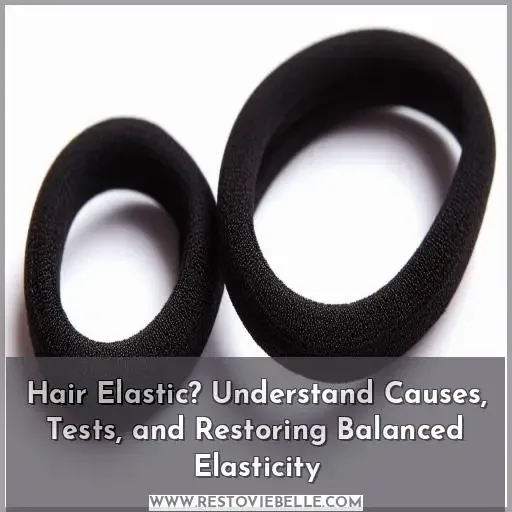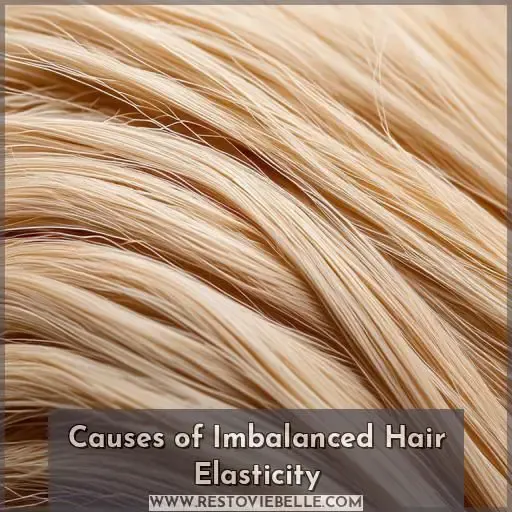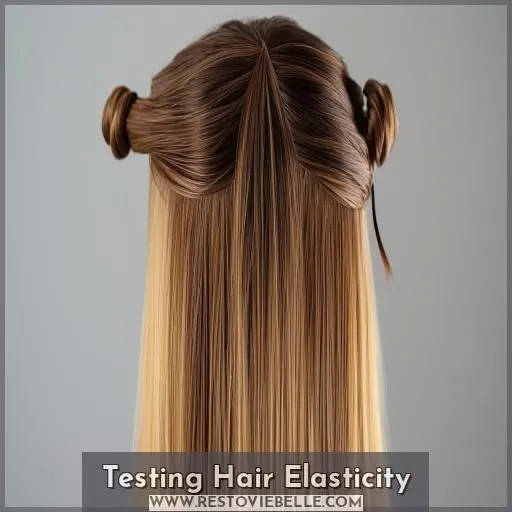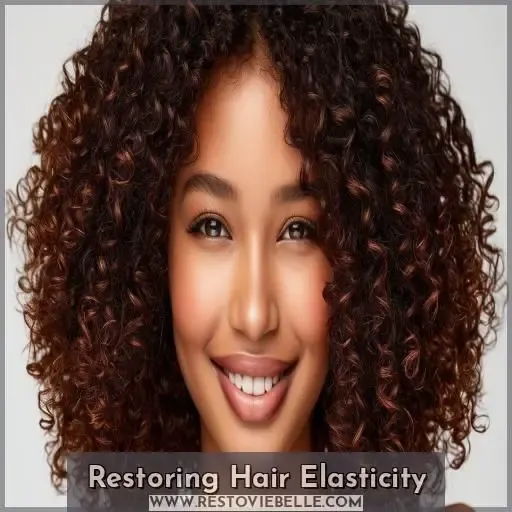This site is supported by our readers. We may earn a commission, at no cost to you, if you purchase through links.
 Your hair’s elasticity refers to its ability to stretch and bounce back to its original shape.
Your hair’s elasticity refers to its ability to stretch and bounce back to its original shape.
If your hair is overly elastic, it could be due to heat or chemical damage, causing the strands to lose their natural strength and integrity.
On the other hand, a lack of moisture or protein can make your hair inelastic, resulting in brittle, dry strands that easily break.
Maintaining balanced elasticity is key for defined, manageable locks.
Table Of Contents
- Key Takeaways
- Why is My Hair Elastic?
- What is Hair Elasticity?
- Causes of Imbalanced Hair Elasticity
- Testing Hair Elasticity
- Restoring Hair Elasticity
- Preventing Elasticity Issues
- Frequently Asked Questions (FAQs)
- What does it mean if your hair is elastic?
- How do you fix elastic hair?
- Why is my hair like a rubber band?
- How do you fix high elasticity in your hair?
- Can hair elasticity change over time?
- Does hair type affect elasticity?
- How often should I test my hair elasticity?
- Can hair extensions impact elasticity?
- Is there a connection between hair growth and elasticity?
- Conclusion
Key Takeaways
- Hair elasticity is a delicate balance between moisture and protein – it’s like a tightrope act where too much of either can send your locks into a spiral of stretchy chaos or brittle breakage.
- Treating your tresses like a newborn babe – handling them gently, minimizing heat exposure, and avoiding harsh chemicals – is key to maintaining that coveted Goldilocks level of elasticity. Ain’t nobody got time for hair that snaps like a rubber band or dangles limply like overcooked spaghetti.
- Putting your hair through the elasticity test is like taking its temperature – a simple strand stretch can reveal if your locks are in tip-top shape or in desperate need of some TLC. It’s like having a secret hair whisperer at your beck and call.
- At the end of the day, your hair’s elasticity is a reflection of its overall health and happiness. Treat it right with a balanced routine tailored to its unique needs, and it’ll reward you with bouncy, resilient strands that could put a Slinky to shame.
Why is My Hair Elastic?
Your hair may feel overly elastic or stretchy for a few reasons:
- Your hair has too much moisture and not enough protein, causing it to feel limp and mushy when wet (Source).
- Damage from excess heat, chemicals, or manipulation has weakened the hair structure, leading to a lack of elasticity and increased breakage .
To restore balanced elasticity, use a protein treatment, avoid over-moisturizing, and handle hair gently to prevent further damage .
What is Hair Elasticity?
Hair elasticity is a key indicator of your hair’s overall health and strength. It measures how well your strands can stretch and bounce back to their original shape without breaking.
When your hair’s elasticity is balanced, your locks will feel defined, strong, and flexible.
However, factors like hydration and protein levels can easily disrupt this delicate balance.
By understanding your hair type and regularly testing its elasticity, you can personalize your hair care routine to maintain ideal elasticity.
Embrace the power of customized hair analysis to target your specific needs and discover the secret to healthy, resilient hair that defies gravity.
Causes of Imbalanced Hair Elasticity
Imbalanced hair elasticity can stem from a lack of moisture, protein damage, excess water exposure, heat damage, or harsh chemical treatments. These factors disrupt the hair’s protein-moisture balance, leading to stretchy, fragile strands prone to breakage.
Lack of Moisture
Lack of moisture is a common culprit behind imbalanced hair elasticity. When your locks are dehydrated, the cuticles lift, leading to moisture loss and a brittle, dry texture. To restore elasticity, prioritize deep conditioning treatments that replenish hydration. Look for products rich in oils, butters, and humectants to seal in moisture and revive your strands.
Protein Damage
Protein damage can leave your hair feeling stiff and brittle. Excessive protein treatments or heat styling can cause the hair cuticle to become damaged, leading to a lack of elasticity. To restore balance, use gentle protein treatments and focus on moisture with deep conditioning masks. Avoid heat styling when possible and opt for air drying or cool settings to prevent further damage (Source).
- Use gentle protein treatments 1-2 times per week
- Deep condition with moisturizing masks to replenish hydration
- Protect hair from heat damage by air drying or using cool settings
Excess Water
Excess water exposure can disrupt your hair’s protein-moisture balance, leading to swelling and loss of elasticity. Prolonged wetness makes hair more prone to breakage. Avoid leaving hair wet for extended periods. Use a wide-tooth comb to gently detangle. Apply a heat protectant spray before styling to prevent further damage from high porosity and brittleness caused by excess water absorption.
Heat Damage
Heat damage from styling tools like blow dryers and flat irons can disrupt your hair’s delicate protein-moisture balance, leading to excessive elasticity. Protect your locks with a heat protectant spray and limit heat exposure. Consider these tips:
- Use lower heat settings
- Allow hair to air dry when possible
- Apply a deep conditioning treatment weekly
- Avoid over-styling with hot tools
Chemical Treatments
Chemical treatments like bleaching, dyeing, and perming can compromise hair integrity, leading to imbalanced elasticity.
These treatments often result in bleach damage, dye damage, or perm damage.
To maintain hair integrity, it’s critical to understand and address the impact of chemical treatments on hair elasticity.
A nuanced hair routine can help counteract the potential negative effects of these treatments and restore balanced elasticity.
Testing Hair Elasticity
To test your hair’s elasticity, take a single wet strand and gently pull it taut; the degree to which it stretches before breaking or returning to its original length indicates whether your hair has low, balanced, or high elasticity. Understanding your hair’s elasticity level is essential, as it reflects its overall strength and guides your hair care routine.
How to Do the Hair Elasticity Test
To test your hair’s elasticity, gently pull a single strand of hair. If it stretches up to 50% of its length and bounces back without breaking, your hair has good elasticity. Stretching a wet strand or a dry strand both work. Observe the amount of stretch and whether the hair returns to its original shape to determine if your hair has low, balanced, or high elasticity.
- Select a single hair strand
- Wet the strand or test on dry hair
- Slowly pull the strand
- Observe the amount of stretch before breakage
- Results indicate low, balanced, or high elasticity
Importance of Hair Elasticity
Hair elasticity is essential for healthy, strong hair. It allows your locks to bend without breaking and indicates proper moisture and protein balance. Stretchy, resilient hair is a sign of vitality, while brittle strands signal damage. To maintain ideal elasticity:
- Avoid excessive heat styling
- Use gentle, moisturizing products
- Get regular trims to prevent split ends
Prioritizing hair elasticity is key to achieving your best, most beautiful mane.
Restoring Hair Elasticity
If your hair lacks elasticity, you’ll need to incorporate moisture-rich treatments to help restore suppleness and bounce. Highly elastic hair, on the other hand, requires protein-based products to rebuild strength and resilience.
Low Elasticity
When dealing with low hair elasticity, it’s crucial to identify the causes and implement appropriate remedies to restore balanced elasticity.
Focus on maintaining a protein-moisture balance to address the underlying causes of low elasticity.
Incorporating specific techniques and products like deep conditioners, protein treatments, and heat protectant sprays can effectively restore and maintain elasticity.
Consider gentle hair handling and regular protein treatments as part of your regimen.
High Elasticity
If your hair is stretchy and lacks body, it likely needs protein. Fortifying shampoos and conditioners can help, but for deep repair, opt for:
- Protein treatments to rebuild damaged strands
- Egg masks for a natural protein boost
- Reconstructive deep conditioners to restore strength and flexibility
Avoid heat and chemicals until elasticity is restored. With the right care, stretchy hair can regain its bounce.
Balanced Elasticity
Balanced hair elasticity is key to maintaining healthy and strong hair. To restore balanced elasticity, consider the following:
- Use protein treatments to strengthen the hair and restore its natural elasticity.
- Incorporate moisture treatments to guarantee the hair retains its flexibility and resilience.
- Deep conditioners with reconstructive properties aid in restoring the balance of protein and moisture, contributing to balanced hair elasticity.
Preventing Elasticity Issues
Preventing elasticity issues in your hair is key to maintaining its strength and health. You should handle your hair gently, especially when wet, establish a balanced routine with protein treatments and moisture-rich products, and always use heat protection when styling.
Gentle Handling
To prevent elasticity issues, handle your hair gently, especially when wet. Use a wide-tooth comb or your fingers to detangle, and avoid excessive brushing or styling. Protect your hair from heat damage by using heat protectant products and limiting the use of hot tools. Maintain a balanced protein-moisture routine to keep your hair healthy and strong.
- Use a wide-tooth comb or fingers to detangle wet hair
- Avoid excessive brushing and styling when hair is wet
- Apply heat protectant products before using hot tools
- Maintain a balanced protein-moisture routine for healthy hair
Balanced Routine
Achieving a balanced hair routine is key to maintaining ideal elasticity. Incorporate regular protein and moisture treatments suited to your hair’s needs. Use wide-tooth combs to gently detangle, and make sure your products provide the right balance of strengthening proteins and nourishing moisture. With a personalized, balanced routine, you’ll enjoy healthy, elastic hair that looks and feels its best.
Heat Protection
To prevent heat damage, use heat protectant sprays and tools with adjustable heat settings. Limit hot water exposure when washing hair. Wear a hat or use an umbrella to shield hair from sun exposure. With a balanced routine and gentle handling, you can maintain healthy, elastic hair that bounces back without breaking.
Frequently Asked Questions (FAQs)
What does it mean if your hair is elastic?
If your hair is elastic, it means it can stretch without breaking. This indicates healthy, strong strands with proper moisture and protein levels. Balanced elasticity is ideal for resilient hair.
How do you fix elastic hair?
To fix elastic hair, balance protein and moisture with treatments like deep conditioning masks. Use bond-repairing products and heat protectants to rebuild strength and prevent further damage.
Why is my hair like a rubber band?
You hit the rubber-band hair jackpot, pal! Too much moisture absorption led to stretchy strands. But don’t sweat it – a good protein treatment will whip that elasticity right into shape.
How do you fix high elasticity in your hair?
To fix high elasticity, strengthen strands with protein treatments. Use bond-repairing products like Olaplex, apply heat protectants, and limit stressors like coloring or heat styling for a while. With care, you’ll restore elasticity.
Can hair elasticity change over time?
Yes, hair elasticity can change with age, hormones, diet, and the overall health of your hair. Proper care, like avoiding heat and chemicals, using gentle products, and getting regular trims, can help maintain ideal elasticity over time.
Does hair type affect elasticity?
Yes, your hair type impacts elasticity. Fine hair tends to be more elastic, while coarse strands have less give. Understanding your hair’s unique needs helps tailor an effective routine.
How often should I test my hair elasticity?
Like a mirror reflecting your inner radiance, regularly testing hair elasticity empowers you to unleash your crowning glory’s true potential. Aim for every 6-8 weeks – consistency is key.
Can hair extensions impact elasticity?
Yes, hair extensions can impact elasticity. They add weight and tension, stressing strands. Monitor extension wear time and opt for lighter options to prevent excessive stretching or breakage.
Is there a connection between hair growth and elasticity?
Yes, hair elasticity is directly related to hair growth. As your hair grows, the outer layer (cuticle) becomes more compact, resulting in reduced elasticity and increased brittleness over time.
Conclusion
Balanced elasticity symbolizes healthy, resilient locks. Why is your hair elastic? It boils down to moisture, protein, and minimizing damage. Test your strands for proper elasticity, and address any imbalances promptly. Protect, nourish, and handle your hair gently to maintain ideal bounce-back – the secret to defined, manageable tresses.










